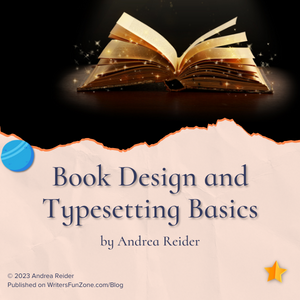Book Design and Typesetting Basics by Andrea Reider
 Let’s welcome back Andrea Reider as she shares with us “Book Design and Typesetting Basics” Enjoy!
Let’s welcome back Andrea Reider as she shares with us “Book Design and Typesetting Basics” Enjoy!
***
I came to book design and typesetting as a recently graduated English major from University of Michigan.
I graduated in 1985, which was one of the first years of the Macintosh computer and the beginning of what was then called “desktop publishing” — a term that has pretty much gone out of use and was sometimes associated with lower quality work.
I’ve been called by many names, including designer, typesetter, layout artist, and formatter. I personally like “typesetter” best, but some publishers have told me that it makes me sound old-fashioned and behind the times, which is not how I want to present myself.
I graduated from college without ever having used a desktop computer.
My first job out of college was managing a typesetting shop that was just converting over to the new Apple Macintosh computer. Turned out that I was pretty good at using the Mac, and then I became permanently fascinated by book design and typesetting.
Because I didn’t have an art or design background or professional training, I began by typesetting books and had very little to do with making design decisions.
Over the years, I began to understand the principles of book design and then went on to develop my own style and confidence in my design abilities.
What is Book Design All About?
I think one of the things that led me to book design and typesetting is that I’ve always loved doing jigsaw puzzles.
Typesetting a book has a lot in common with a jigsaw puzzle — both require focus and perseverance — but jigsaw puzzles always end up the same result no matter what you do.
A book in the hands of another designer would look substantially different, based on the designer’s preferences and typographic decisions.
Book design is all about the creative, appropriate, and best presentation of material.
As a typesetter/formatter I look at every element on the page in a different way, including the endings and beginnings of every line of text on the page — looking for bad hyphenation or right or loose lines, or anything that I can fix or improve.
Typesetting is all about consistency — applying the design to each element in the book in a consistent and regular manner.
There are always exceptions that come up while working on a book (such as when a chapter title is too long to fit in the space for the running header, or bad page breaks caused by text boxes or images.)
In these cases the typesetter decides to let one aspect of the design be inconstant in order to fit in all of the elements on the pages in the best way possible.
I worked as a freelance book typesetter for ten years before I even thought about designing books on my own.
And it took another ten years for me to feel comfortable asking anyone to hire me to design their book cover.
And then came e-books, which took many years for me to master.
Constant learning and adapting to changes in the publishing process was driven mostly by necessity — it was the only way for me to keep working on a regular and long-term basis.
There was a time when I only had to be a good typesetter, and no publisher would ever consider sending a book cover design to a typesetter, but the lines of who does what have blurred a lot in the time that I’ve been working in publishing, and the expectations for what one person should do continues to change.
The Mysteries of Typesetting
The first mystery of book design that I began to solve was, “How does the designer decide what the book should look like?”
There are endless options for typefaces and graphic elements, but I realized that as a designer my job was to pick some options and develop the design from there.
I typically start to design a book by laying out the frontmatter pages (title page, copyright, dedication, table of contents, etc.) through a chapter or two.
After I have the first design sample looking the way I want it to, I then work to develop at least two other samples as variations that can be similar or very different.
The design for a book interior can be as simple as using only text with chapter numbers and titles set in a professional and appealing manner. Some designs can include geometric, floral, abstract printer ornaments (also known as “dingbats”) that suit or enhance the topic — or readability — in some way.
There are many different ways to use boxes, circles, and lines to develop a unique — or familiar — look for the design of the book. If the book cover is available — or If I am designing the book cover — I always try to use the fonts from the cover in some way along with any other elements that can be picked up.
Finalizing the Design
I work on a lot of different types of books: from all-text fiction books to complicated non-fiction books with dozens or hundreds of photographs, illustrations, and other elements.
I also work on illustrated children’s books, where the main goal is to choose the right type faces and place the text in the best spot in the illustration.
Once the design is finalized, the book is ready for the complete layout.
I usually need anywhere from 3 to 7 days to complete the layout for most books, depending on length and complexity of the text and the number of figures, tables, text boxes, math equations, and sometimes, Greek or Latin text.
The next stage is for the author and/or editor to review the complete PDF of the book that I send.
I expect to see 20-50 revisions for the typical book, but some books run into hundreds or thousands of revisions and require many rounds back and forth to finalize for print.
I make EPUB e-books for about half of the books that I design and typeset for print.
The text in the e-book should be identical to the print book and does not need a complete new proofread, but you do need to check to make sure there are no missing images or that anything is out of place.
The chapter titles in the Table of Contents should be linked to the text and all website addresses should be linked and activated.
Working with a book designer should be a great and rewarding experience. I work with many publishers who know what to expect, but also a lot of new authors who appreciate the guidance that I can provide them.
Good luck with your book! I’m here if you need me.
***
ABOUT THE AUTHOR
 Andrea Reider has been working as a book designer and layout artist/typesetter for publishers and self-publishing authors since graduating from the University of Michigan in English in 1985 with a B.A. in English. It was the year of the Macintosh computer and “desktop publishing,” and her first job was managing a typesetting shop in Ann Arbor.
Andrea Reider has been working as a book designer and layout artist/typesetter for publishers and self-publishing authors since graduating from the University of Michigan in English in 1985 with a B.A. in English. It was the year of the Macintosh computer and “desktop publishing,” and her first job was managing a typesetting shop in Ann Arbor.
When Andrea moved to San Francisco two years later her Macintosh skills were very much in demand. Andrea began working as a freelancer for several book publishers and has been at it ever since. Her clients have included John Wiley & Sons, Addison Wesley Longman, McGraw Hill, Rowman & Littlefield, and hundreds of self-publishing authors.
Website: http://www.reiderbooks.com
Instagram: https://www.instagram.com/andreareiderdesign/






